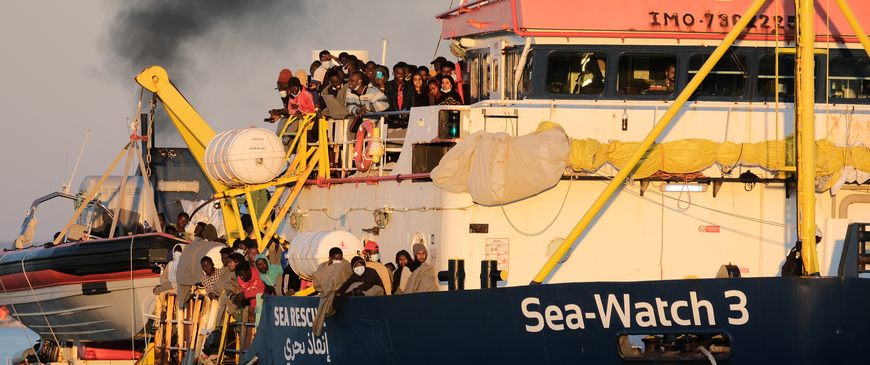
Europe's migration problems are back
The migration spat between France and Italy is a reminder that EU migration politics continue to be toxic, and that Europe’s common migration and asylum system remains incomplete.
Earlier this month, migration returned as a top item on the EU's agenda. The number of migrants arriving in Italy has risen substantially in recent years (see Chart 1) and the new Italian government led by Giorgia Meloni, which had made the fight against irregular migration one of its hallmark policies, has unsurprisingly taken a confrontational line. In June, a group of countries struck an ad-hoc agreement to take in around 10,000 migrants disembarking in Italy and other south European countries. But the mechanism has been very slow to get off the ground, much to Italy’s annoyance. Rome is particularly irked by the operations of non-governmental organisations’ (NGO) rescue vessels in the Mediterranean, which the government argues are working unsupervised and making life easier for migrant smuggling networks, particularly in Libya and Tunisia. It has sought to block them from disembarking rescued migrants in Italian ports, arguing that the country whose flag the vessels fly should be responsible. Italy has also loudly demanded solidarity from its European partners in taking in migrants.
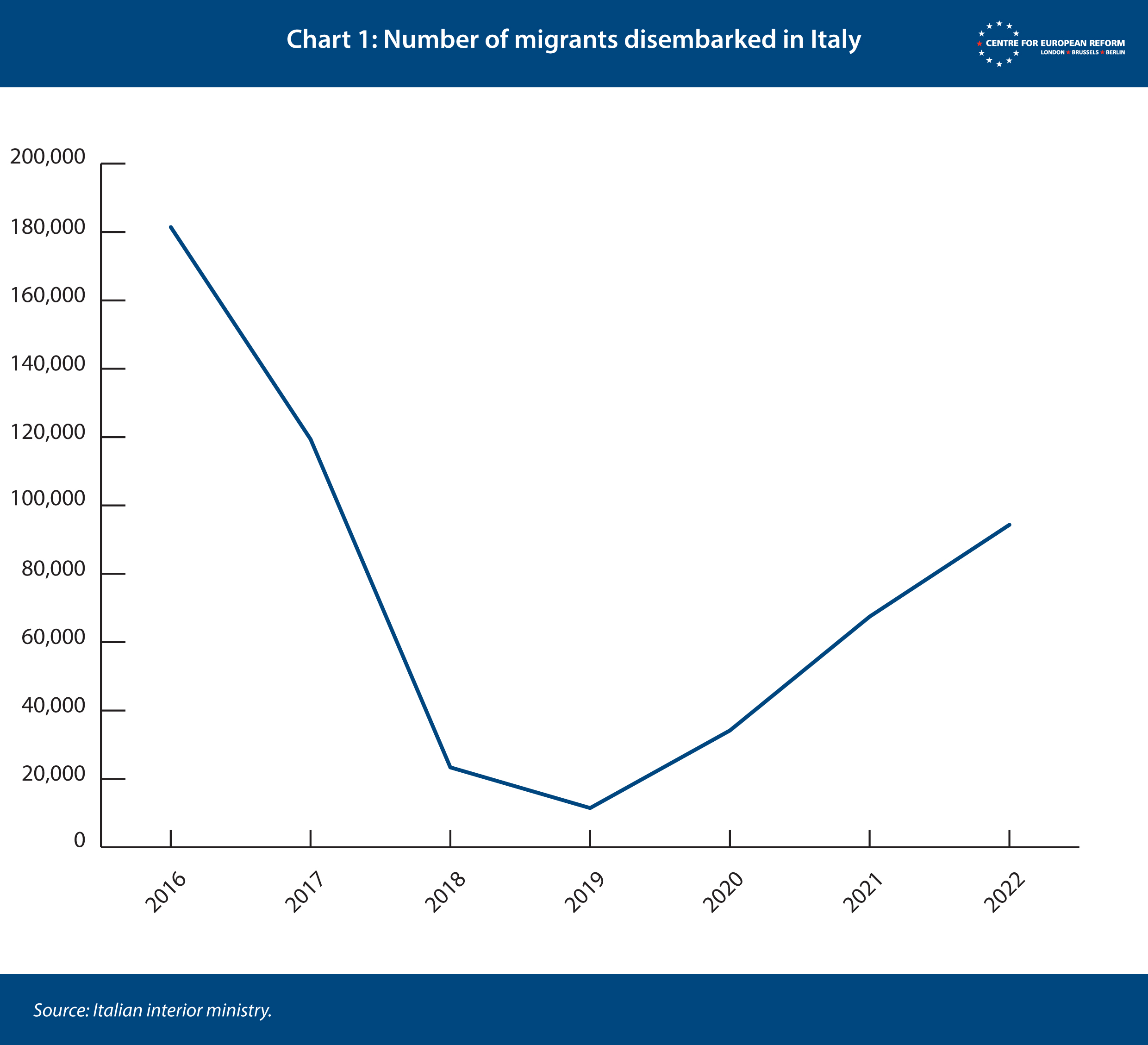
A serious row with France broke out in early November after Italy refused to disembark rescued migrants from the ship Ocean Viking, operated by a French NGO under a Norwegian flag. After almost three weeks at sea, and repeated calls for permission to disembark in Italy, Spain and France, the vessel eventually made its way to the French port of Toulon, as conditions on board deteriorated. French officials were furious with their Italian counterparts, with interior minister Gérald Darmanin warning of “extremely severe consequences for bilateral relations and European relations”. France said it would suspend its planned relocation of 3,500 migrants who had arrived in Italy (as part of the June deal), and threatened further retaliation. Italian officials played down the dispute, but there is little sign that Rome plans to change its approach.
Europe’s common migration and asylum system remains incomplete.
The Franco-Italian spat on migration is hardly the first time Italy and France have clashed on the issue. There were substantial tensions in 2018-19 when the Five Star League coalition was in government. The latest row is the direct result of Giorgia Meloni’s new policy on migration, and French President Emmanuel Macron’s unwillingness to appear weak domestically by giving in to her demands. At the same time, it is a reminder that Europe’s common migration and asylum system remains incomplete, and that this will continue to cause friction between member-states. It may also gradually erode the functioning of the Schengen border-free area – one of the EU’s pillars. Following the spat, France increased existing controls at its borders with Italy, and there were reports of queues forming at crossing points.
At the core of the current system is the notion that member-states along the EU’s external border are almost always responsible for processing the asylum applications of migrants who arrive – and this places a very large burden on them. Efforts to reform this system have been underway since around 1.4 million people entered the EU during the 2015-2016 crisis. At the time, the EU institutions attempted to introduce more burden-sharing by proposing a law that said all member-states had to take in some migrants arriving in EU countries on the external border. But this attempt failed because some countries, like Hungary and Poland, refused to take in any migrants, while others only took in token numbers.
Over recent years the Commission, and the different member-states holding the EU’s rotating Presidency, have proposed a range of ideas to try to break the impasse. The Commission’s most recent proposals were the ‘new migration pact’ of 2020, which was made up of three core ideas. First, the pact would harmonise asylum procedures and standards and speed up the processing of applications at the EU’s borders, with different systems for migrants who are likely to be granted asylum and those who are not. Second, a solidarity mechanism would be introduced that would allow member-states to take in migrants from countries of first entry, or to provide practical help like financing or assistance in returning those whose asylum applications failed. Third, the Commission wanted to increase co-operation with migrants’ countries of origin, to ensure that migrants whose asylum applications failed could be smoothly returned. To do this, the Commission proposed carrots, like opening more legal routes for migrants, but also sticks, like suspending visa facilitation agreements with countries that refused to co-operate.
The migration deal was ambitious: initially, the Commission said that nothing would be agreed until everything was agreed. The idea was to avoid the piece-meal approach that had been marring the EU’s efforts to fix its migration woes; and to push reluctant member-states to agree to a common solution by allowing them to reject quotas and help with returns instead. In the end, this plan proved too optimistic, as Central and East European governments refused to play ball while front-line countries grew increasingly angry. Ultimately, the Commission and EU leaders decided to advance on those parts of the deal that were more palatable for all. In January this year, the EU established a fully-fledged EU Agency for Asylum, to harmonise asylum standards across the EU and with more staff to help member-states. There has also been some progress in negotiations on screening procedures for migrants arriving at the EU’s border and on setting up a database to better monitor asylum seekers, so that they do not lodge multiple applications in different member-states.
The debate on solidarity will remain particularly thorny.
But migration is not an EU priority, with the Union’s attention taken up by the war in Ukraine, the energy crisis, the green agenda, trade tensions with the US and the rule of law dispute with Hungary and Poland. That means that, while further progress on single files is possible, it is unlikely that the EU will be able to conclude negotiations on all migration legislation by the end of the current legislative period in 2024. The debate on solidarity will remain particularly thorny. Italy and other member-states along the EU’s external border want other member-states' help in dealing with migrants, especially by relocating a substantial share of arrivals. Some EU states, like Germany and France, are prepared to show solidarity, including by relocating some migrants, but do not want to move away from the principle that border countries are responsible for processing asylum applications in most cases. However, the real stumbling block to progress is that some member-states, particularly Poland and Hungary, are opposed to taking in migrants from non-European countries.
Internal disagreements mean that the focus of EU migration policy will continue to be on the policy that all member-states agree on – reducing the number of migrants reaching Europe. The EU has taken several steps to do this. First, member states have increased controls over their land and sea borders, with Poland virtually sealing its borders and growing evidence of pushbacks of migrants by Greece. Three operations by Frontex, the EU’s border agency, and one EU military mission, operation Irini, are underway in the Mediterranean to counter people smuggling. Frontex is also present at the EU’s borders with the Western Balkans and the Commission wants to deploy the agency to the non-EU borders of the Western Balkan countries. In 2021, the Commission has proposed legislation that would allow member-states to derogate from their normal asylum obligations when third countries use migration as a weapon against the EU, as Belarus has done, making it easier for member-states to deny migrants entry.
Second, the EU has been trying to work with partners to reduce the number of migrants that reach Europe. The EU is training and funding the Libyan coastguard, despite evidence that it is involved in abuses of migrants, and funding the Egyptian one. The Union runs a civilian operation in Niger, EUCAP Sahel Niger, which helps the country to counter smuggling and control irregular migration. The EU has also provided funds to strengthen border controls and infrastructure in countries like Morocco and funded programmes to support the millions of refugees in Turkey. Spain and Italy also co-operate bilaterally with Morocco, Tunisia, Libya and Senegal to tighten controls.
Third, the EU collectively and member-states individually have tried to deepen co-operation with third countries to increase the number of returns of migrants whose asylum applications have been rejected. The EU has sought to use incentives such as offers of funding and partnerships to foster skills transfers and promote circular migration. But the Union also wants to make greater use of political pressure to, for example, restrict the issuing of visas to countries that do not co-operate, as it has done with Senegal and Gambia.
These efforts have had mixed success. Returns remain particularly challenging: in 2021, 342,000 people were ordered to leave the EU but only 83,000 were returned. Broadly speaking, the EU has found it easier to work with countries in the Western Balkans and to its east, while co-operation with its African neighbours has been more difficult. Non-EU governments are not always willing to work with Brussels on taking back their own citizens or those who are found to have crossed their countries en route to the EU, partially because of the domestic political blowback of looking like they are acting as Europe’s enforcers. Even when they are willing to co-operate, not all countries have the necessary capacity to comply with EU return rules. Often, it is tempting for the EU’s partners to hold back on co-operation and demand a higher price for working with the Union.
So long as the deadlock over solidarity continues, the EU’s efforts will continue to be focused on dealing with the external dimension of migration.
So long as the deadlock over solidarity continues, the EU’s efforts will continue to be focused on dealing with the external dimension of migration, as all the member-states can agree on reducing the number of irregular entries. But the EU will not be able to reduce the number of arrivals to zero, and disagreements over burden sharing will continue to divide member-states. That means that the spat between France and Italy could well be first of many such episodes. With her economic agenda constrained by EU policies and the bond markets, the temptation for Meloni to play tough on migration will continue. Even if she wanted to ease relations with Macron, her coalition partner and League leader Matteo Salvini may well calculate that continued confrontation serves his interests well. Macron himself will probably not shy away from confrontation, as being tough towards Italy’s migration demands plays well with both the left and the right in France.
Whatever other member-states think of Italy’s current policies on migration, the lack of visible solidarity has been an issue for all recent Italian governments. And Meloni’s position is shared by other south European countries, with Malta, Greece and Cyprus raising the same issues about burden sharing in a joint statement with Italy earlier this month. If the EU wants to break its migration and asylum impasse and put Schengen on a more solid footing, it needs to build trust and show that solidarity can be meaningful. Ensuring that the ad-hoc solidarity mechanism established in June can work is the essential starting point.
Eventually, Meloni may calculate that the damage done to Italy’s broader interests by confrontational policies on migration outweighs their benefits. Other member-states should be ready to offer more solidarity to coax her towards that conclusion.
Luigi Scazzieri is a senior reseach fellow at the Centre for European Reform.

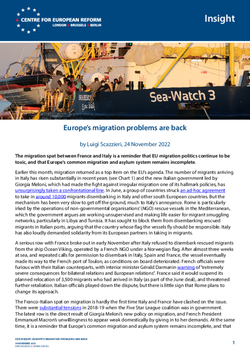
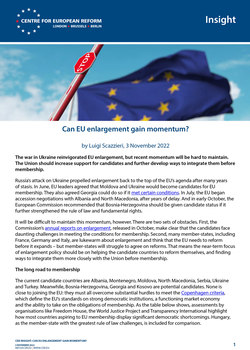
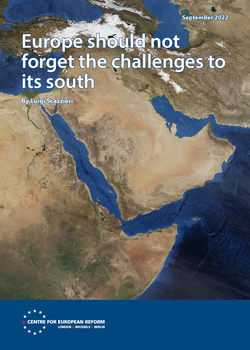
Add new comment